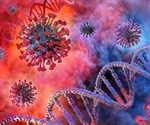
Latest Coronavirus Disease COVID 19 News and Research
Making gyms safer: Why the virus is less likely to spread there than in a bar
After shutting down in the spring, America’s empty gyms are beckoning a cautious public back for a workout. To reassure wary customers, owners have put in place — and now advertise — a variety of coronavirus control measures.
Kids are missing critical windows for lead testing due to pandemic
Families skipping or delaying pediatric appointments for their young children because of the pandemic are missing out on more than vaccines. Critical testing for lead poisoning has plummeted in many parts of the country.
Danish household SARS-CoV-2 study shows low transmission from children
Using data from the national register in Denmark, researchers studied how likely persons infected with the severe acute respiratory syndrome coronavirus 2 (SARS-CoV-2) transmit it within their households. The study found additional household members tested positive in 17% of cases after one person in the household was infected. The research is published on the preprint server medRxiv in September 2020.
Seroconversion marks recovery from COVID-19
Nine months into the COVID-19 pandemic, scientists are still seeking to understand the protective immunity that develops against the causative agent severe acute respiratory syndrome coronavirus 2 (SARS-CoV-2). Despite the increasing need for serological tests in epidemiology, their clinical value has not been fully established. A new paper published in the Journal of Medical Virology in September 2020 describes the relationship of COVID-19 disease symptoms with the serological status over time.
New review explores the role of antibodies and T-cells towards an effective COVID vaccine
More than 100 companies have rushed into vaccine development against COVID-19 as the U.S. government pushes for a vaccine rollout at "warp speed" -- possibly by the end of the year -- but the bar set for an effective, long-lasting vaccine is far too low and may prove dangerous, according to Marc Hellerstein of the University of California, Berkeley.
Study shows how the pandemic unfolded across the world
A new study combines evolutionary genomics from coronavirus samples with computer-simulated epidemics and detailed travel records to reconstruct the spread of coronavirus across the world in unprecedented detail.
Study shows people prefer combination of apps and humans for coronovirus contact tracing
People prefer coronavirus contact tracing to be carried out by a combination of apps and humans, a new study shows.
Comprehensive analysis of antibody responses in COVID-19 patients can help develop effective vaccine
A comprehensive analysis of antibody responses in coronavirus disease 2019 (COVID-19) patients could inform the development of an effective vaccine, according to a study published September 10 in the open-access journal PLOS Pathogens by Chao Wu and Rui Huang of Nanjing University Medical School, and colleagues.
Study sheds light on the disproportionate impact of COVID-19
As the first wave of the COVID-19 pandemic was receding in mid-May, some 1.3 million working-age adults reported being home sick with symptoms they attributed to the coronavirus.
New book gives overview of viruses and how they emerge to cause pandemics
Since the novel coronavirus SARS-Cov-2 emerged late last year, it has been virtually impossible to consume any news without encountering stories about the virus and how it spreads, potential treatments, and the development of new vaccines.
Effective, simple, safe self-amplifying RNA vaccines
A recent review paper in the journal Current Opinion in Virology in September 2020 shows how a new generation of RNA vaccines called self-amplifying RNA vaccines are more potent than conventional mRNA vaccines and could hold the key to the global production of cost-effective potent COVID-19 vaccines.
Researchers explore IgA response to SARS-CoV-2
A new study published on the preprint server bioRxiv* and conducted by researchers from The Rockefeller University in New York examined the role of IgA antibodies in preventing SARS-CoV-2 infection. In this study, the team analyzed the IgA response to SARS-CoV-2 infection in 149 individuals.
Bedrails, door handles and ECG monitors hotspots for SARS-CoV-2 in hospital wards
A new study published in the journal Science of The Total Environment in September 2020 reports that the virus can be detected rapidly using already available technology, which will help to monitor viral spread within healthcare facilities more closely and enable better control of the pandemic.
High blood pressure awareness and control worsening in the U.S.
Published in the journal JAMA, the study finds that a growing percentage of adults in the United States have uncontrolled high blood pressure, which is known as the “silent killer” and a significant risk factor for severe illness from the coronavirus disease (COVID-19).
Researchers say Influenza may increase risk of COVID-19
A recent study by researchers suggests that the spread of severe acute respiratory syndrome coronavirus 2 (SARS-CoV-2) is influenced by influenza virus infection during the initial period of coronavirus disease 2019 (COVID-19) pandemic in Europe. The study is currently available on the medRxiv preprint server.
Over half a million reported child COVID-19 cases in the United States
The American Academy of Pediatrics (AAP) and the Children's Hospital Association have come up with a joint report on the number of children affected by COVID-19 across the United States. Over half a million children have been infected with severe acute respiratory syndrome coronavirus 2 (SARS-CoV-2), they point out. Their report titled, "Children and COVID-19: State Data Report," was released on 3rd September 2020.
Strict social distancing associated with lower chances of coronavirus infection
Using public transportation, visiting a place of worship, or otherwise traveling from the home is associated with a significantly higher likelihood of testing positive with the coronavirus SARS-CoV-2, while practicing strict social distancing is associated with a markedly lower likelihood, suggests a study from researchers at the Johns Hopkins Bloomberg School of Public Health.
Detecting SARS-CoV-2 in 30 seconds with cheap and sensitive nanotubes
In a fascinating new medRxiv preprint paper, researchers from the University of Nevada, Reno demonstrate the power of cobalt-functionalized titanium dioxide nanotubes by selectively detecting the spike glycoprotein of the severe acute respiratory syndrome coronavirus 2 (SARS-CoV-2) in less than 30 seconds.
Alternative UK air travel guidance likely needed to address COVID-19
Researchers have said that the UK guidance on preventing severe acute respiratory syndrome coronavirus 2 (SARS-CoV-2) from being imported via air travel does prevent a significant proportion of infectious travelers from putting people at risk of coronavirus disease 2019 (COVID-19).
The mental health impact of COVID-19 in Australian adolescents
A new study conducted by researchers at the University of New South Wales has indicated the extent to which adolescents in Australia have been psychologically affected by the coronavirus disease 2019 (COVID-19) pandemic.



_65342bea19c1462ab560234f52b60b18-150x125.jpg)







_cde0ad4520c443a495072e7875f1a9b8-150x125.jpg)






_615eae76bc31474db7c6653f50822b0c-150x125.jpg)























.png)









No hay comentarios:
Publicar un comentario